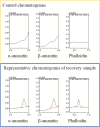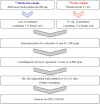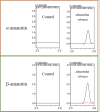Development of Simultaneous Analytical Method of Three Polypeptide Toxins α-Amanitin, β-Amanitin and Phalloidin in Poisonous Mushrooms and Human Serum Using UHPLC-MS/MS
- PMID: 40396548
- PMCID: PMC12093918
- DOI: 10.1002/jms.5145
Development of Simultaneous Analytical Method of Three Polypeptide Toxins α-Amanitin, β-Amanitin and Phalloidin in Poisonous Mushrooms and Human Serum Using UHPLC-MS/MS
Abstract
Accidental ingestion of toxic mushrooms remains a global public health concern because of the presence of highly potent peptide toxins such as α-amanitin, β-amanitin, and phalloidin. These compounds exhibit strong hepatotoxicity and can lead to acute liver failure and death. However, their rapid detection in biological and food matrices remains analytically challenging. Existing methods often require extensive sample preparation and are not suitable for urgent diagnostic applications. This study presents the development and validation of a rapid and sensitive analytical method for the simultaneous quantitation of α-amanitin, β-amanitin, and phalloidin in poisonous mushrooms and human serum. Among several preparation strategies evaluated, a method following direct extraction with 1% formic acid in methanol was selected for its speed, simplicity, and effectiveness in minimizing matrix interference. The method demonstrated excellent linearity (r2 ≥ 0.99), low quantitation limits (10-50 ng/mL), and satisfactory recovery (72%-117%) and precision (RSD ≤ 19%) in both food and biological matrices. When applied to field-collected Amanita virosa, α-amanitin and β-amanitin were detected at 39 and 145 mg/kg, respectively, whereas no toxins were found in Amanita volvata. These findings demonstrate that the established method enables rapid and reliable detection of lethal peptide toxins with minimal sample preparation. The protocol is suitable for forensic investigations, clinical toxicology, and food safety monitoring. Its applicability in emergency settings underscores its potential as a practical tool for improving public health responses to mushroom poisoning incidents.
Keywords: UHPLC–MS/MS; mushroom; quantitative analysis; serum; toxins.
© 2025 The Author(s). Journal of Mass Spectrometry published by John Wiley & Sons Ltd.
Conflict of interest statement
The authors declare no conflicts of interest.
Figures






Similar articles
-
[Determination of five amanita peptide toxins in poisonous mushrooms by ultra performance liquid chromatography-quadrupole electrostatic field orbitrap high resolution mass spectrometry].Se Pu. 2023 Jan;41(1):94-103. doi: 10.3724/SP.J.1123.2022.03010. Se Pu. 2023. PMID: 36633081 Free PMC article. Chinese.
-
Detection and quantification of Amatoxin in wild mushrooms from North-East India using HPLC-PDA method for food safety purposes.Toxicon. 2024 Nov 28;251:108134. doi: 10.1016/j.toxicon.2024.108134. Epub 2024 Oct 21. Toxicon. 2024. PMID: 39442569
-
[Highly sensitive determination of three kinds of amanitins in urine and plasma by ultra performance liquid chromatography-triple quadrupole mass spectrometry coupled with immunoaffinity column clean-up].Se Pu. 2022 May 8;40(5):443-451. doi: 10.3724/SP.J.1123.2021.08018. Se Pu. 2022. PMID: 35478003 Free PMC article. Chinese.
-
Amatoxin-Containing Mushroom Poisonings: Species, Toxidromes, Treatments, and Outcomes.Wilderness Environ Med. 2018 Mar;29(1):111-118. doi: 10.1016/j.wem.2017.10.002. Epub 2018 Jan 8. Wilderness Environ Med. 2018. PMID: 29325729 Review.
-
Ribosomal biosynthesis of the cyclic peptide toxins of Amanita mushrooms.Biopolymers. 2010;94(5):659-64. doi: 10.1002/bip.21416. Biopolymers. 2010. PMID: 20564017 Free PMC article. Review.
References
-
- Govorushko S., Rezaee R., Dumanov J., and Tsatsakis A., “Poisoning Associated With the Use of Mushrooms: A Review of the Global Pattern and Main Characteristics,” Food and Chemical Toxicology 128 (2019): 267–279. - PubMed
-
- White J., Weinstein S. A., De Haro L., et al., “Mushroom Poisoning: A Proposed New Clinical Classification,” Toxicon 157 (2019): 53–65. - PubMed
-
- Gonmori K. and Yoshioka N., “Mushroom Toxins,” in Drugs and Poisons in Humans: A Handbook of Practical Analysis (Springer, 2005), 469–480.
-
- Gonmori K. and Yoshioka N., “The Examination of Mushroom Poisonings at Akita University,” Legal Medicine 5 (2003): S83–S86. - PubMed
-
- Sharma S. and Singh R., “Mushroom Poisoning: From Toxicity to Forensic Analysis,” Journal of the Indian Society of Toxicology 12 (2016): 43–48.
MeSH terms
Substances
LinkOut - more resources
Full Text Sources

